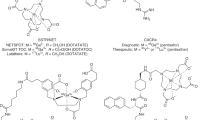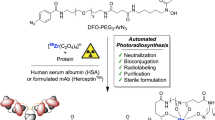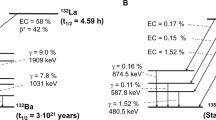Abstract
Gallium-68 (68Ga) is a generator-produced radionuclide with a short half-life (t½ = 68 min) that is particularly well suited for molecular imaging by positron emission tomography (PET). Methods have been developed to synthesize 68Ga-labeled imaging agents possessing certain drawbacks, such as longer synthesis time because of a required final purification step, the use of organic solvents or concentrated hydrochloric acid (HCl). In our manuscript, we provide a detailed protocol for the use of an advantageous sodium chloride (NaCl)-based method for radiolabeling of chelator-modified peptides for molecular imaging. By working in a lead-shielded hot-cell system,68Ga3+ of the generator eluate is trapped on a cation exchanger cartridge (100 mg, ∼8 mm long and 5 mm diameter) and then eluted with acidified 5 M NaCl solution directly into a sodium acetate-buffered solution containing a DOTA (1,4,7,10-tetraazacyclododecane-1,4,7,10-tetraacetic acid) or DOTA-like chelator-modified peptide. The main advantages of this procedure are the high efficiency and the absence of organic solvents. It can be applied to a variety of peptides, which are stable in 1 M NaCl solution at a pH value of 3–4 during reaction. After labeling, neutralization, sterile filtration and quality control (instant thin-layer chromatography (iTLC), HPLC and pH), the radiopharmaceutical can be directly administered to patients, without determination of organic solvents, which reduces the overall synthesis-to-release time. This procedure has been adapted easily to automated synthesis modules, which leads to a rapid preparation of 68Ga radiopharmaceuticals (12–16 min).
This is a preview of subscription content, access via your institution
Access options
Subscribe to this journal
Receive 12 print issues and online access
$259.00 per year
only $21.58 per issue
Buy this article
- Purchase on Springer Link
- Instant access to full article PDF
Prices may be subject to local taxes which are calculated during checkout








Similar content being viewed by others
References
Menda, Y. et al. Repeatability of gallium-68 DOTATOC positron emission tomographic imaging in neuroendocrine Tumors. Pancreas 42, 937–943 (2013).
Production of Long Lived Parent Radionuclides for Generators, 68Ge, 92Sr, 90Sr and 188W. (International Atomic Energy Agency, 2010) http://www-pub.iaea.org/MTCD/publications/PDF/Pub1436_web.pdf.
Velikyan, I. Prospective of 68Ga-radiopharmaceutical development. Theranostics 4, 47–80 (2014).
de Blois, E. et al. Characteristics of SnO2-based 68Ge/68Ga generator and aspects of radiolabelling DOTA-peptides. Appl. Radiat. Isot. 69, 308–315 (2011).
Meyer, G.J., Mäcke, H., Schuhmacher, J., Knapp, W.H. & Hofmann, M. 68Ga labelled DOTA-derivatised peptide ligands. Eur. J. Nucl. Med. Mol. Imaging 31, 1097–1104 (2004).
Eder, M. et al. Novel preclinical and radiopharmaceutical aspects of [68Ga]Ga-PSMA-HBED-CC: A new PET tracer for imaging of prostate cancer. Pharmaceuticals 7, 779–796 (2014).
Zhernosekov, K.P. et al. Processing of generator produced 68Ga for medical application. J. Nucl. Med. 48, 1741–1748 (2007).
Roesch, F. Post-processing via cation exchange cartridges: versatile options. in Theranostics, Gallium-68 and Other Radionuclides. Recent Results in Cancer Research Vol. 194 (eds. Baum, R.P. and Roesch, F.) 33–42 (Springer-Verlag, 2012).
Eppard, E., Wuttke, M., Nicodemus, P.L. & Rösch, F. Ethanol-based post-processing of generator-derived 68Ga toward kit-type preparation of 68Ga-radiopharmaceuticals. J. Nucl. Med. 55, 1023–1028 (2014).
Seemann, J., Eppard, E., Waldron, B.P., Ross, T.L. & Roesch, F. Cation exchange-based post-processing of 68Ga-eluate: a comparison of three solvent systems for labelling of DOTATOC, NO2AP(BP) and DATA(m.). Appl. Radiat. Isot. 98, 54–59 (2015).
Müller, D., Klette, I. & Baum, R.P. The combined cationic-anionic purification of the 68Ge/68Ga generator eluate for the labeling of fragile peptides. World J. Nucl. Med. 10, 77–78 (2011).
Loktionova, N.S. et al. Improved column-based radiochemical processing of the generator produced 68Ga. Appl. Radiat. Isot. 69, 942–946 (2011).
Mueller, D. et al. Simplified NaCl based 68Ga concentration and labeling procedure for rapid synthesis of 68Ga radiopharmaceuticals in high radiochemical purity. Bioconjug. Chem. 23, 1712–1717 (2012).
Schultz, M.K., Mueller, D., Baum, R.P., Leonard Watkins, G. & Breeman, W.A.P. A new automated NaCl based robust method for routine production of gallium-68 labeled peptides. Appl. Radiat. Isot. 76, 46–54 (2013).
Maina, T. et al. Preclinical and first clinical experience with the gastrin-releasing peptide receptor-antagonist [68Ga]SB3 and PET/CT. Eur. J. Nucl. 43, 964–973 (2016).
Baum, R.P. et al. First-in-human study demonstrating tumor-angiogenesis by PET/CT imaging with Ga-68-NODAGA-THERANOST, a high-affinity peptidomimetic for alpha(v)beta(3) integrin receptor targeting. Cancer Biother. Radiopharm. 30, 152–159 (2015).
Miller, S.A., Dykes, D.D. & Polesky, H.F. A simple salting out procedure for extracting DNA from human nucleated cells. Nucleic Acids Res. 16, 1215 (1988).
Mao, Y.J., Sheng, X.R. & Pan, X.M. The effects of NaCl concentration and pH on the stability of hyperthermophilic protein Ssh10b. BMC Biochem. 8, 28 (2007).
Dominy, B.N., Perl, D., Schmid, F.X. & Brooks, C.L. The effects of ionic strength on protein stability: the cold shock protein family. J. Mol. Biol. 319, 541–554 (2002).
Lindman, S. et al. Salting the charged surface: pH and salt dependence of protein G B1 stability. Biophys. J. 90, 2911–2921 (2006).
Šimeček, J., Hermann, P., Wester, H.J. & Notni, J. How is 68Ga labeling of macrocyclic chelators influenced by metal ion contaminants in 68Ge/68Ga generator eluates? ChemMedChem 8, 95–103 (2013).
Chakravarty, R., Chakraborty, S., Dash, A. & Pillai, M.R. Detailed evaluation on the effect of metal ion impurities on complexation of generator eluted 68Ga with different bifunctional chelators. Nucl. Med. Biol. 40, 197–205 (2013).
'2.4.8 Heavy Metals'. European Pharmacopoeia 8th edn. 128–131 (Council of Europe, 2010).
Author information
Authors and Affiliations
Contributions
D.M. conceived and developed the original NaCl-based method; W.A.P.B. and I.K. revalidated the procedures and optimized the conditions; M.G. suggested suitable cation-exchange resigns and the NaCl elution from SCX cartriges; M.B. and A.O. evaluated the method from medical point of view; and I.T. and M.K.S. tested the procedure on different generators. All authors wrote and edited the manuscript.
Corresponding author
Ethics declarations
Competing interests
The authors declare no competing financial interests.
Integrated supplementary information
Supplementary Figure 1 Scheme 1
Software interface module diagram of the automated radiosynthesis system (ModularLab PharmTracer, Eckert & Ziegler) used to prepare 68Ga DOTATOC by the NaCl based method.
Supplementary information
Supplementary Figure
Supplementary Figure 1 (PDF 233 kb)
Rights and permissions
About this article
Cite this article
Mueller, D., Breeman, W., Klette, I. et al. Radiolabeling of DOTA-like conjugated peptides with generator-produced 68Ga and using NaCl-based cationic elution method. Nat Protoc 11, 1057–1066 (2016). https://doi.org/10.1038/nprot.2016.060
Published:
Issue Date:
DOI: https://doi.org/10.1038/nprot.2016.060
This article is cited by
-
Application of response surface methodology and quality by design to [68Ga]Ga-PSMA-11 preparation
Journal of Radioanalytical and Nuclear Chemistry (2024)
-
Microfluidic-based production of [68Ga]Ga-FAPI-46 and [68Ga]Ga-DOTA-TOC using the cassette-based iMiDEV™ microfluidic radiosynthesizer
EJNMMI Radiopharmacy and Chemistry (2023)
-
Radiolabeled nanomaterial for cancer diagnostics and therapeutics: principles and concepts
Cancer Nanotechnology (2023)
-
Production and purification of 43Sc and 47Sc from enriched [46Ti]TiO2 and [50Ti]TiO2 targets
Scientific Reports (2023)
-
Development and application of a fully automatic multi-function cassette module Mortenon M1 for radiopharmaceutical synthesis
Annals of Nuclear Medicine (2023)
Comments
By submitting a comment you agree to abide by our Terms and Community Guidelines. If you find something abusive or that does not comply with our terms or guidelines please flag it as inappropriate.



